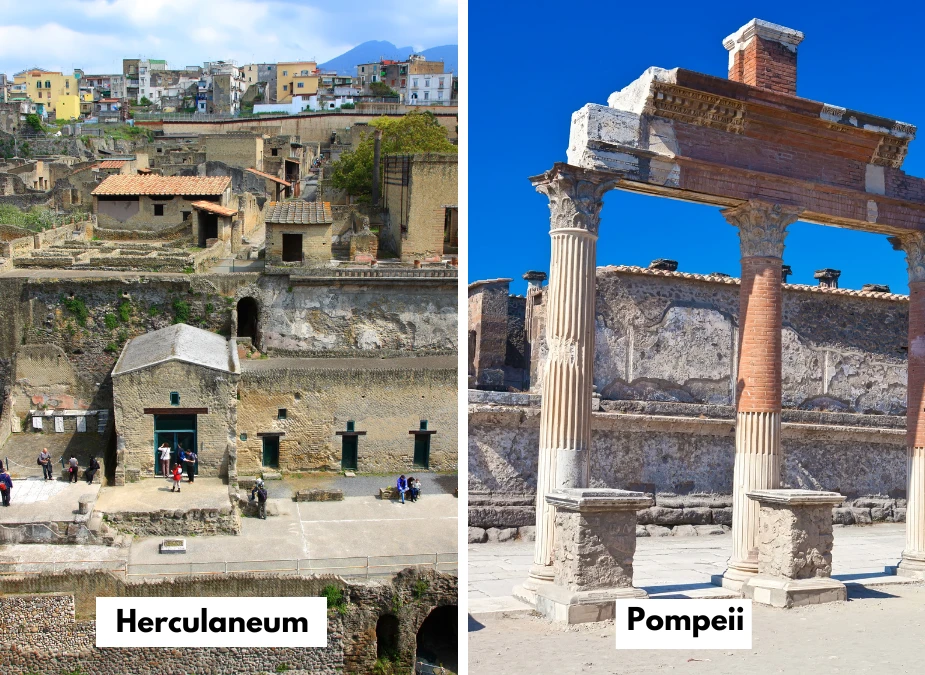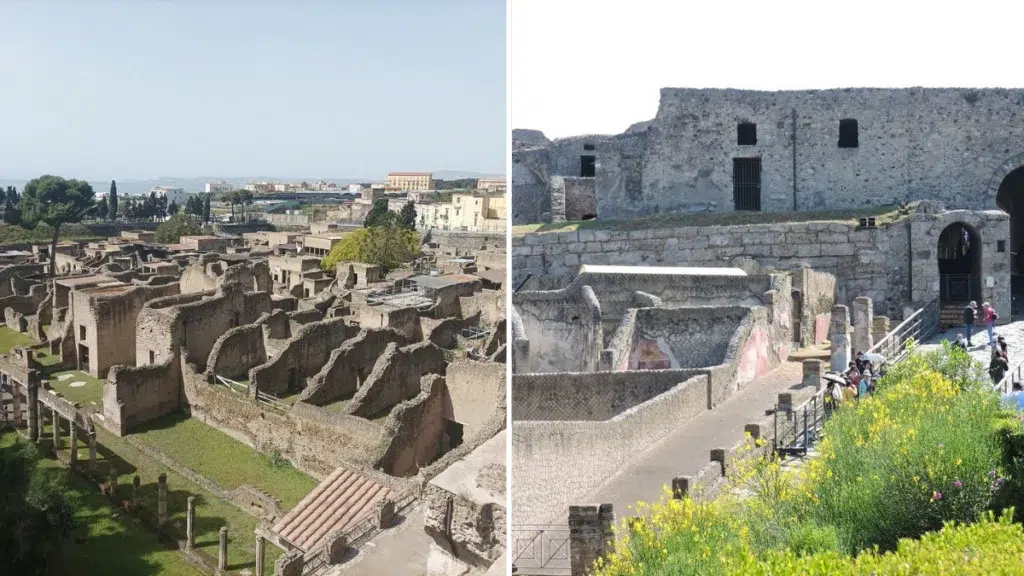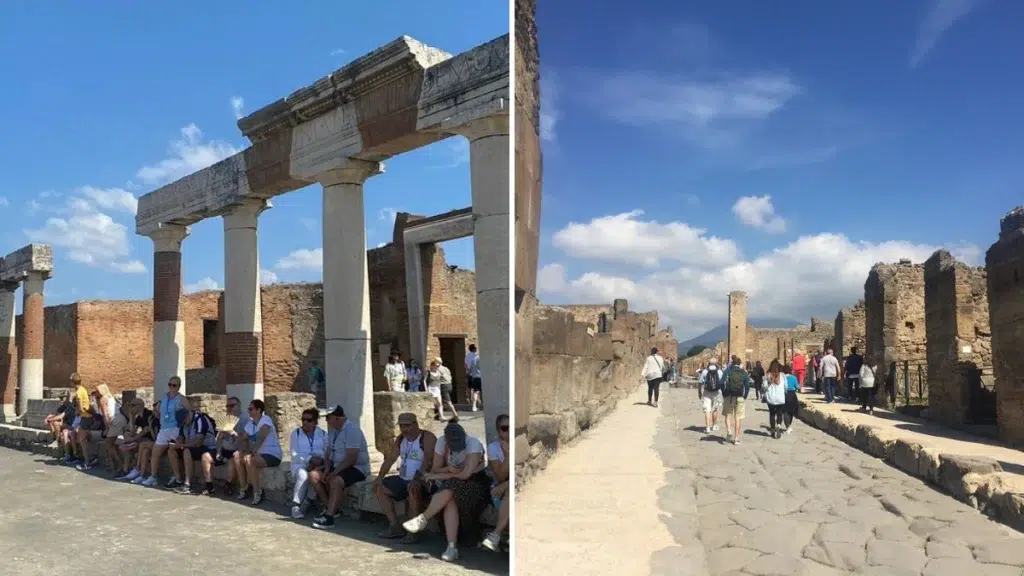Located 9 miles (14 km) apart, Herculaneum and Pompeii are Italy’s two most popular archeological sites.
Both were highly civilized ancient Roman cities destroyed by the volcanic eruption of Mount Vesuvius in AD 79.
People often plan to visit these sites but are often confused about which one is better and which one they should visit.
This article will compare Herculaneum and Pompeii based on certain factors, including ticket price, size, what to see, etc.
Let’s start with a brief introduction and comparison table!
Herculaneum vs Pompeii: Our Recommendation
When choosing between Herculaneum and Pompeii, our top recommendation is Pompeii.
Pompeii is ideal for those seeking an immersive experience of ancient Roman life.
It has vast open spaces, well-preserved ruins, stunning frescoes, and iconic landmarks like the Amphitheater, Forum, and Villa of the Mysteries.
Pompeii’s rich history and extensive excavations make it a perfect option for history enthusiasts and casual visitors. You need to set aside a day to visit it.
However, if you plan a whole day and want to explore them, we recommend visiting Herculaneum, which can be covered in less time.
Can I do Pompeii and Herculaneum in one day?
It is technically possible to visit both Pompeii and Herculaneum in one day, as they are located relatively close to each other in the Campania region of Italy.
However, due to the large size of these archaeological sites and the exhaustion it may cause, covering both in a day is not recommended.
Pompeii and Herculaneum: A Brief Introduction

Pompeii is the world’s largest archeological site, covering an area of 170 acres.
It provides a view of ancient Roman life through its well-preserved frescoes, mosaics, and structures.
Herculaneum, although smaller in size, covers an area of 50 hectares.
It has remarkably well-preserved buildings, including intact homes, shops, and public structures.
Both attractions are UNESCO World Heritage Sites, giving a peek at ancient Roman lives.
Quick Comparison
| Pompeii | Herculaneum | |
|---|---|---|
| Tickets: | Pompeii tickets cost € 25 for adults aged 18+ years. | Herculaneum tickets also cost € 25 for adults aged 18+ years. |
| Address: | Via Villa dei Misteri, 1, 80045 Pompei, NA, Italy | Corso Resina, 187, 80056 Ercolano, NA, Italy |
| Size: | Pompeii covered an area of around 66 hectares and may have had a population of 10,000 to 20,000 residents. | Herculaneum covered an area of about 20 hectares and had a population of around 4,000. |
| Wealth: | Pompeii was less wealthy compared to Herculaneum. | Herculaneum was wealthier than Pompeii. |
| Effect of Eruption: | Pompeii was buried under tons of pyroclastic material. | Herculaneum was destroyed by mud and scorching gas. |
| Excavation | Pompeii is nearly 70% excavated, even though a third is still buried under debris. | Herculaneum is estimated to have been excavated for only 20%. |
| Opening Hours | Open: 9 am Closes: Between 5 pm and 7 pm Holidays: 25 December (Christmas Day), 1 January (New Year’s Day), and 1 May (Labour Day) | Open: 8.30 am Closes: Between 5 pm and 7.30 pm Holidays: 25 December (Christmas Day), 1 January (New Year’s Day), and 1 May (Labor Day) |
| Best time to visit | Between November and March, Early Morning | Between November and March, Early Morning |
| Time Taken | Requires 4-5 hours or one full day to | It can be explored in half a day |
| Uniques Features | Plaster casts of victims, visible throughout the site | Fossilized organic material and Skeletons, mainly found near the ancient beach |
| Distance from Naples | 24 km, located far from Naples | 11 km, located closer to Naples |
Pompeii vs. Herculaneum Ticket Price: Which One is Cheaper?
A basic entry ticket to Pompeii costs €25 for adults, with a discounted rate of only €8 for children aged 17 years and under and EU citizens aged between 18 and 24.
Similarly, a standard Herculaneum ticket costs €25 for adults aged 18 and above.
EU citizens aged between 18 and 24 pay a discounted fee of €17, whereas children under 17 pay €11.
You also get an audio guide in 5 languages, Spanish, English, French, German, and Italian, for your visit.
If you plan a budget trip, Pompeii is the better option, covering a larger area at a much cheaper rate.
| Visitors | Pompeii Tickets | Herculaneum Tickets |
|---|---|---|
| Adult (18+ years) | €25 | €25 |
| Child (up to 17 years) | €8 | €11 |
| EU Citizens ( 18 to 24 years) | €8 | €17 |
| Book Now | Book Now |
History of Herculaneum vs Pompeii

Pompeii was a popular city in ancient Rome, on the base of Mount Vesuvius.
Those who established the city had no idea about the volcanic nature of Vesius.
In 79 AD, Mount Vesuvius erupted violently, covering Pompeii in ash and debris.
This disaster happened so suddenly that no one had time to escape, and volcanic ash buried the city, preserving it for centuries.
Over time, people forgot about Pompeii until it was rediscovered centuries later, in 1549, during digging a water channel.
Excavations began and revealed the well-preserved remains of ancient Roman life, which are popularly known as the Ruins of Pompeii or Pompeii Archaeological Park today.
Learn More about Pompeii’s History→
Similarly, Herculaneum suffered during the eruption of Mount Vesuvius in 79 AD, although it had a different fate.
While Pompeii was buried under layers of volcanic ash, Herculaneum was hit by a fast-moving flow of superheated gas and ash.
This resulted in the instant killing of its inhabitants and preserved the city in a different way.
Unlike Pompeii, where many structures collapsed under the weight of ash, Herculaneum’s buildings remained intact.
The preservation of organic materials, such as wooden furniture and food, gives researchers valuable insights into the everyday lives of its residents.
Both cities share similar histories; Pompeii offers a better glimpse of the incident, and Herculaneum offers a better glimpse of ancient Roman life.
How Long to Spend at Pompeii and Herculaneum?
Pompeii covers a larger area and has many houses, villas, statues, frescoes, amphitheaters and brothels to visit.
You must set aside at least one full day to cover the site without missing any attractions.
However, if you want to only experience the highlights of Pompeii, it will take around 4-5 hours.
If you are short on time, consider taking a guided tour of Pompeii.
In contrast, Herculaneum, much smaller and more compact, can be thoroughly explored in about half a day.
Its better-preserved buildings, complete with upper floors and everyday artifacts, take less time to visit.
However, if you are a history buff, it can take longer to appreciate its beauty and preservation.
Visiting Herculaneum vs. Pompeii: What Is There to See?
Both sites offer remarkable things to see inside them.
Pompeii has nearly 1500 buildings, including various attractions such as brothels, villas, gyms, bathhouses, parks, statues, etc.
Some of the most popular attractions there include:
Amphitheater:

The oldest Roman amphitheater, built in 70 B.C., seats 20,000 people and is famous for gladiator games and the 1972 Pink Floyd concert.
Antiquarium
The museum at the site entrance displays household objects, tools, and plaster casts of victims.
Pompeii Houses
There are many Pompeii houses, with the two best-preserved being the House of Faun and Vetti. These houses showcase elaborate decorations and artifacts from wealthy families.
Bathhouses
There are many types of bathhouses with well-preserved and different facilities, Forum Baths, Stabian Baths, and Suburban Baths, which tell about Roman hygiene and social practices.
Pompeii Gym (Palaestra Grande)
Palastra is an ancient gym with exercise areas, and a swimming pool was built in the Augustan period
Forum of Pompeii
Forum is a central public square surrounded by important buildings, offering a stunning view of Mount Vesuvius.
Villa of Mysteries
The Villa of Mysteries is famous for its well-preserved frescoes, including a painting depicting a young girl joining a secret club.
Brothels in Pompeii
Brothels are special areas with rooms and erotic art on the wall. One notable brothel is Lupanar, highlighting ancient Roman life’s social and economic aspects.
Similarly, there are many things to see in Herculaneum, which include:
Ancient Spas
The Suburban Spa and Urban Spa feature separate sections for males and females, with facilities such as deep pools, stucco friezes, bas-reliefs, and marble seats and floors.
Gaudí’s masterful architectural design is now displayed in this vast hall with distinctive Doric columns.
Casa dello Scheletro (Skeleton’s House)
Named for the complete human skeleton found here, this house is notable for its five styles of mosaic flooring and a system of white arrows guiding guests. The internal courtyard includes a skylight with remnants of an ancient security grill.
Casa dei Cervi (Deers’ House)
A large, noble family’s house with a central courtyard, murals, and still-life paintings. Outside, find marble deer statues and a statue of a drunken, peeing Hercules.
Casa di Nettuno e Anfitrite (House of Neptune and Amphitrite)
Known for the stunning mosaic of Neptune and Amphitrite in the triclinium (dining room) and a mosaic-encrusted nymphaeum (shrine to water nymphs).
Casa del Tramezzo di Legno (Wooden Screen’s House)
Unique for its two atria and a well-preserved wooden screen dividing the atrium from the tablinum (office). It includes the remains of an ancient bed.
While both Pompeii and Herculaneum offer many things to visit, Pompeii offers a better experience due to its larger area and more things to see.
Crowds at Herculaneum vs Pompeii

Due to its smaller size and lesser-known status, visitors can generally expect fewer crowds at Herculaneum than at Pompeii.
Also, the restricted capacity of certain areas and the preference for guided tours contribute to a more controlled flow of visitors.
On the other hand, Pompeii’s larger size and worldwide fame attract larger crowds, especially during peak tourist seasons.
Despite its expansive layout, certain popular areas within Pompeii may still experience significant congestion, particularly during peak hours.
For an experience with fewer crowds, you can consider Herculaneum over Pompeii.
Opening Hours of Herculaneum vs Pompeii
When planning your visit, it’s important to note the opening hours of both Pompeii and Herculaneum, which vary slightly and have seasonal closing times.
Depending on the season, Pompeii opens at 9 am and closes between 5 pm and 7 pm.
Herculaneum opens a bit earlier, at 8.30 am, and closes between 5 pm and 7.30 pm.
Both sites are closed on major holidays such as 25 December (Christmas Day), 1 January (New Year’s Day), and 1 May (Labor Day).
So, before planning a visit, check the Herculaneum and Pompeii opening hours and closing times.
Herculaneum vs Pompeii: Best time to visit
Although Italy attracts the highest crowds during the summer due to holidays and the heat of the Italian summer, avoiding these peak months is advisable.
You can visit Pompeii in shoulder seasons from March to May and resume again in mid-September.
If you are not worried about the cold weather, you can even visit Pompeii and Herculaneum in winter with fewer visitors and cheap prices.
Tip: No matter which season you visit, plan for an early morning visit, especially on weekdays, to avoid crowds at both sites.
You can learn more about the best time to visit Pompeii here!
FAQs
1. Is Herculaneum better than Pompeii?
Herculaneum offers a more intimate and less crowded experience due to its smaller size and lesser-known status.
However, Pompeii, with its vast open spaces, well-preserved ruins, and iconic landmarks, provides a more extensive exploration of ancient Roman life.
Ultimately, it’s a matter of personal preference.
2. Can I do Pompeii and Herculaneum in one day?
While it is technically possible to visit both Pompeii and Herculaneum in one day, it is not recommended due to the large size of these archaeological sites and the exhaustion it may cause.
3. Is Herculaneum bigger than Pompeii?
No, Pompeii is larger than Herculaneum.
Pompeii covers an area of around 66 hectares, whereas Herculaneum covers an area of about 20 hectares.
Despite its smaller size, the Herculaneum still offers a wealth of well-preserved buildings and artifacts that provide insights into ancient Roman life.
4. What city was destroyed by a volcano?
Both Pompeii and Herculaneum were destroyed by the eruption of Mount Vesuvius in AD 79.
The volcanic eruption buried these ancient Roman cities under layers of ash and debris, preserving them for centuries.
5. How far away was Herculaneum from Pompeii?
Herculaneum is about 11 kilometers away from Pompeii.
Featured Image: Edella from Getty Images




